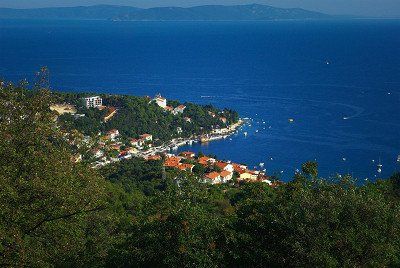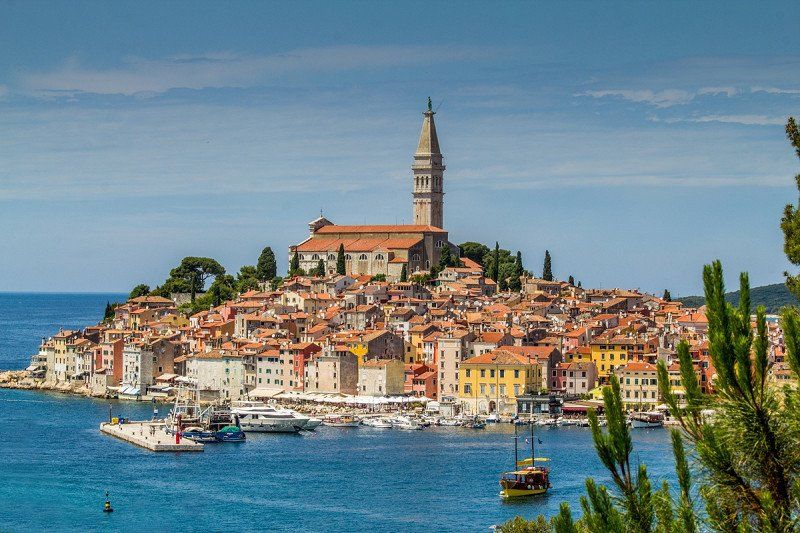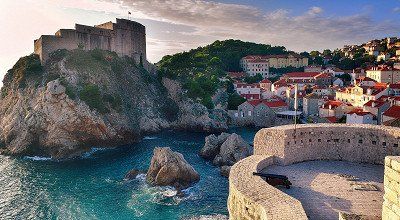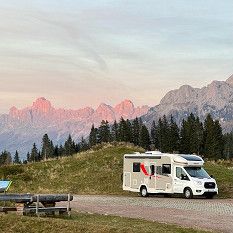When people hear the words Croatia holiday and Istria, they often think of clear turquoise water and picturesque bays. Spending time at the beach is a given when camping in Istria, but there's also a lot to see and enjoy away from the beaches, such as quaint old towns, wild national parks and culinary delights – Istria's not called the peninsula of contrasts for nothing. Freeontour has selected a few amazing places in Istria away from the beach for you to visit on your next motorhome trip or camping holiday.
Contents
Where is Istria?
When is the best time to travel to Istria for campers?
Sights in Istria away from the beach
Natural highlights and outdoor activities in Istria
What are the most beautiful beaches in Istria?
Where are most campsites in Istria?

Where is Istria?
Dense pine forests, rough rock formations and a crystal clear sea: covering an area of 3,500 square kilometres, Istria is the largest peninsula in the northern Adriatic. Located between the Gulf of Trieste and Kvarner Bay, it's a camper's paradise and a Mediterranean gem boasting many hours of sunshine. Most of Istria belongs to Croatia and lies in the northwest of the country. But a portion also lies in Slovenia and Italy. Around 200,000 people live in the region. Depending on where you set off, it might take you only a few hours or a whole day to get there, maybe even longer if travelling with a motorhome or caravan.

When is the best time to travel to Istria for campers?
Istria is blessed with a mild yet not too hot climate. Despite roughly 2,400 hours of sunshine a year, the average temperature in the summer months is around 24 °C. Even at the height of summer, the thermometer rarely rises above 30 °C. The mild sea breeze and dense forests will cool you down. The bathing season in the warm Mediterranean Sea runs from May to October, the water temperature during these months is between 22 and 28 °C. This is one reason why Istria is a great summer destination. If you're not a fan of hot weather and don't want to spend every day on the beach, you will also find a varied region with pleasantly mild temperatures in spring and autumn, the perfect time for hiking and cycling trips.
Sights in Istria away from the beach
Winding alleys, romantic stone houses and wide promenades – all the while eating ice cream, strolling and sauntering through the historic towns of Istria. Numerous picturesque places in the region are waiting to be discovered. A small selection here:

5 most beautiful old towns in Istria
- Pula: what's an ancient amphitheatre doing here by the sea? Istria was a part of the Roman Empire for several centuries and, therefore, part of the Italian world. Bearing witness to this is the famous Pula Arena, which is said to have been the second largest arena in the Roman Empire and is considered to be the sixth largest structure of its kind in the world. Moreover, Pula still has many ancient Roman gates and temples that can be visited and admired. With almost 60,000 inhabitants, it is the largest city in Istria and relatively urban. This lively little town has a wealth of restaurants, bars and museums.
- Rovinj: the old town of Rovinj adorns many a postcard depicting Istria, which explains why it also adorns the title of this article. It is considered to be the architectural jewel of the region and you will find many buildings from the Venetian era here. You could be mistaken for thinking you were looking at a romantic painting when you see how the stone houses rise out of the sea on a round promontory on the west coast of Istria, surrounded by blue water and crowned by a proud church in the centre. Rovinj is a popular tourist destination in Istria. If you're looking for some peace and quiet in the old town, avoid coming here in the high season. Instead, head to Zlatni Rt, the Golden Cape Nature Park, south of the old town. This forest park is one of the most beautiful landscapes in Istria, offering an idyllic natural environment for hiking, cycling or just relaxing as well as wonderful swimming opportunities.

- Poreč: the coastal town of Poreč may not be that exciting, but it is no less picturesque. It also lies on a promontory surrounded by the sea. Built in the 6th century, the Euphrasian Basilica is the oldest early Christian episcopal complex in the world. In 1997, UNESCO declared it a World Heritage Site. Well preserved and worth seeing are three of the original eleven towers of the historic city wall. Small fish restaurants are lined up along the quay.
- Motovun: gracing the top of a hill inland surrounded by green nature is Istria's capital of white truffles and wine. It's worth visiting this town in autumn for these culinary highlights alone. Fresh truffles are available here from September to January. But don't let that stop you coming in spring or summer. The region's Roman past can still be felt in Motovun. From the top of the fort surrounded by an ancient city wall you can enjoy a panoramic view over the green terraced vineyards and forests in Mirna Valley. Incidentally, this is also an ideal location for active holidaymakers to experience the landscape by bike or on foot. If you're looking for some peace and quiet away from the hustle and bustle of the beach, then this is the right place for you. A good starting point for exploring Motovun and the surrounding area is Camper Stop Motovun.

- Opatija: if you want to experience some French Riviera flair, then Opatija is where you need to be. The architecture of this coastal town near the holiday resort of Rijeka looks very different from the rest of Istria. The Art Nouveau buildings capture the spirit of the Belle Époque on the Austrian Riviera (the term used for the seaside resorts on the Istrian coast during the Austro-Hungarian Empire). In fact, Opatija was a winter resort during the 19th century for the aforementioned high society. Today, the magnificent hotels, villas and summer houses radiate nostalgic charm, which gave Opatija its nickname The Old Lady.
Tip: Istria has a few remarkable towns inland, such as Grožnjan, a small artists' village with local artworks and open-air galleries in the narrow streets. And Dvigrad, an abandoned, crumbling medieval ghost town that has been uninhabited since the 18th century and in turn reclaimed by nature. The ruins of the city of Dvigrad tower over the Lim Valley, east of the Lim Channel. The best way to drive to this ruined city is via the access road from Kanfanar. We don't recommend the road through Mrgani as it has some very tight hairpin bends.

Natural highlights and outdoor activities in Istria
- Učka Nature Park: rugged cliffs, deep gorges, wild waterfalls – here at the Učka massif near the coastal town of Rijeka, we are reminded of how contrasting Istria's natural landscape is. A medieval tower (a symbol of the nature park) watches over its highest peak, Vojak (1,401 m). You have a wonderful view from up here. There are plenty of paths for hikers to walk to their hearts' content. Climbing and mountain bike fans as well as paragliders will also find a favourable terrain here. Moreover, the park is home to unique flora and fauna. Učka is the only place in the world where you can take photos of the native cliff bellflower – and one of the few mountains in Europe where griffon vultures and golden eagles regularly circle in the sky. The area is also famous for its chestnuts and wild asparagus.
- Brijuni Islands National Park: separated from the Istrian mainland by the narrow Fažana Strait, the Brijuni islands lie opposite Pula and Fažana. This paradisaical archipelago consists of 14 islands that form the Brijuni National Park. However, only the largest of the islands, Veliki Brijun, is open to the public. This car-free island is best reached from the coastal town of Fažana. At the harbour you can book a boat to the island with a 4-hour guided panoramic train tour through the national park for around €35. If you prefer to discover the island on your own, you can purchase a boat ticket with Pocket Guide for just under €30 (prices as of May 2022). You can also rent bicycles or electric scooters on the island. You may take your own bike or scooter with you as well provided you register in advance and pay a fee to the ferry company. If you only want to make a short stopover in the area, you will also find a motorhome pitch at the port.
Video: Visiting Brijun island – from Tito to a safari park
You'll definitely get your money's worth here as there is plenty to see and do on the island – from Tito's vintage Cadillac and other Cold War historical relics, to a safari park and bird sanctuary, to an underwater trail in Verige Bay that you can explore with a snorkel through to a dinosaur trail with footprints, fossils and geopaleontological sites.

- Cape Kamenjak: the Cape Kamenjak Nature Park is located on the southernmost tip of Istria. Tourists come here to experience the roughly 30 km of rugged coastline, uninhabited small islands, spectacular cliffs and natural beaches and bays. The cape is one of the few stretches of coastline in the Mediterranean where the endangered, elusive monk seal is still a rare visitor. An extensive network of hiking and biking trails runs through the park, offering cinematic views of the sea and countryside. But don't be alarmed if someone suddenly somersaults into the abyss in front of you – the cape is a popular spot for cliff jumping. The park has an entrance fee. If you decide to come with your own vehicle, you'll pay around €10 for a car and around €20 for a campervan.
- Discover Istria's underworld: Istria is famous for its caves and grottos. A visit to the surreal natural wonders is always a journey back in time to the geological past of the region. The impressive Baredine Cave northeast of Poreč is not far from the coast and one of the most popular tourist destinations on the Istrian peninsula. It is also the only stalactite cave in Istria that is open to the public. But you can also admire another natural spectacle inland at Pazin Cave near the town of Pazin: at the end of a 500 m long gorge, the Pazinčica river trickles into a ponor, a sinkhole. Although the grotto itself cannot normally be accessed by the general public, the surrounding area with its medieval castle, nature trails and waterfalls is just waiting to be explored.
What are the most beautiful beaches in Istria?
If you're camping in Istria, then obviously a day or two at the beach should be on your agenda – even though the region is simply too spectacular for a pure beach holiday. It's quite easy to find a nice beach in Istria because beaches and small, charming rocky bays are dotted all along the roughly 500 km coast of the peninsula. However, most of the beaches are pebbly, so flip-flops would definitely make life easier. But Istria also has a few beautiful sandy beaches:

5 tips for beautiful sandy beaches in Istria
- Bijeca Beach at the seaside resort of Medulin: the roughly 1.5 km long sandy beach with its fine, beige sand is one of the most popular beaches in Istria. The water here is also wonderfully shallow.
- Beach Zambratija north of Umag: the small sandy beach is an insider tip. There is a quiet flair here, hardly any hustle and bustle and an authentic beach bar.
- Valbandon Beach at the seaside resort of Fažana: a creamy white, fine pebble beach with a sandbank for sunbathing in the shallow, clear water. Sunbathers can also enjoy a view of the islands of Brijuni National Park.
- Cyclon's Beach west of Pula: rugged rock formations with a wild and romantic pine forest and a mix of pebble and sandy beaches. The turquoise water is perfect for snorkelling and the Grotto of Pula in mysterious rock caves is within walking distance. Tip: you can go on a kayak tour to the grotto from Pula.
- Lone Bay Beach at the seaside resort of Rovinj: a dense, shady pine forest runs down to the idyllic, sheltered bay. There is a beach bar with bamboo loungers and sunshades.

































